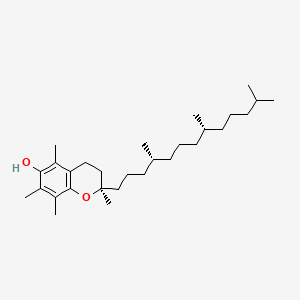Ferroptosis-centered Drug Response Information
General Information of the Drug (ID: ferrodrug0031)
| Name |
Alpha-Tocopherol
|
||||
|---|---|---|---|---|---|
| Synonyms |
alpha-Tocopherol; VITAMIN E; D-alpha-Tocopherol; 59-02-9; 5,7,8-Trimethyltocol; (+)-alpha-Tocopherol; Phytogermine; TOCOPHEROL; 2074-53-5; Aquasol E; (R,R,R)-alpha-Tocopherol; Syntopherol; Viteolin; Eprolin; Esorb; a-Tocopherol; (2R,4'R,8'R)-alpha-Tocopherol; Tocopherol alpha; dl-a-Tocopherol; alpha Tocopherol; Profecundin; Denamone; Epsilan; Tokopharm; Vascuals; Viprimol; Etavit; alpha-Tokoferol; Evion; alpha-Tocopherol, D-; d-a-tocopherol; alpha-Vitamin E; Vitamin E alpha; Eprolin S; Viterra E; E Prolin; E-Vimin; D-alpha tocopherol; Lan-E; Med-E; Antisterility vitamin; alpha-Tocopherol acid; Tenox GT 1; Vi-E; Rhenogran Ronotec 50; (2R)-2,5,7,8-TETRAMETHYL-2-[(4R,8R)-4,8,12-TRIMETHYLTRIDECYL]CHROMAN-6-OL; Covitol F 1000; E 307 (tocopherol); (R)-2,5,7,8-Tetramethyl-2-((4R,8R)-4,8,12-trimethyltridecyl)chroman-6-ol; Vitamin Ea; a-D-Tocopherol; Tocopherol (R,S); (+)-a-Tocopherol; CCRIS 3588; 1406-18-4; CHEBI:18145; Vitamin-E; 2,5,7,8-Tetramethyl-2-(4',8',12'-trimethyltridecyl)-6-chromanol; HSDB 2556; EINECS 200-412-2; NSC 20812; Evitaminum; Waynecomycin; Almefrol; E307; Emipherol; Etamican; Vitayonon; Ilitia; (2R)-2,5,7,8-tetramethyl-2-[(4R,8R)-4,8,12-trimethyltridecyl]-3,4-dihydro-2H-chromen-6-ol; H4N855PNZ1; BPBio1_000362; 18920-62-2; Vitaplex E; DTXSID0026339; E 307; Spavit E; EC 200-412-2; ido-E; Endo E; N9PR3490H9; Vita E; a-Vitamin E; (2R)-2,5,7,8-tetramethyl-2-[(4R,8R)-4,8,12-trimethyltridecyl]-3,4-dihydrochromen-6-ol; 2H-1-Benzopyran-6-ol, 3,4-dihydro-2,5,7,8-tetramethyl-2-[(4R,8R)-4,8,12-trimethyltridecyl]-, (2R)-; (+/-)-alpha-Tocopherol; rel-alpha-Vitamin E; 2H-1-Benzopyran-6-ol, 3,4-dihydro-2,5,7,8-tetramethyl-2-[(4R,8R)-4,8,12-trimethyltridecyl]-, (2R)-rel-; DTXCID706339; MFCD00072045; RRR-alpha-tocopherol; CAS-59-02-9; 2H-1-Benzopyran-6-ol, 3,4-dihydro-2,5,7,8-tetramethyl-2-((4R,8R)-4,8,12-trimethyltridecyl)-, (2R)-; 2H-1-Benzopyran-6-ol, 3,4-dihydro-2,5,7,8-tetramethyl-2-(4,8,12-trimethyltridecyl)-, (2R-(2R*(4R*,8R*)))-; 2H-1-Benzopyran-6-ol, 3,4-dihydro-2,5,7,8-tetramethyl-2-(4,8,12-trimethyltridecyl)-, [2R-[2R*(4R*,8R*)]]-; SMR000471844; VIV; 3,4-Dihydro-2,5,7,8-tetramethyl-2-(4,8,12-trimethyltridecyl)-2H-benzopyran-6-ol; (all-R)-alpha-Tocopherol; DTXSID8021355; Phytogermin; Palmvtee; alpha-Tocoferol; (+-)-Med-E; UNII-N9PR3490H9; Vitamin Ealpha; NSC-20812; Alpha-tocopherols; .ALPHA.-TOCOPHEROL, D-; Pheryl-E; DL--Tocopherol; Vita plus E; rel--Vitamin E; -Vitamin E; Vitamin e d-alpha; NCGC00016688-02; Prestwick_653; EINECS 215-798-8; EINECS 218-197-9; .alpha.-Vitamin E; Envirose 100; NSC 82623; COVIREL; RRR-alpha-tocopheryl; Vitamin E [USP]; ()-alpha-Tocopherol; delta-alpha-tocopherol; alpha-delta-Tocopherol; Tocopherol, d-alpha-; CONTROX VP; EPROLIN-S; Vitamin E (D-form); TENOX GT; CHEMBL47; (R,R,R)-a-Tocopherol; Prestwick3_000404; (+)- alpha -Tocopherol; (+)-.alpha.-Tocopherol; bmse000600; R,r,r-.alpha.-tocopherol; alpha-TOCOPHEROL (II); SCHEMBL3097; COVI-OX T 30P; RIKKI N 70; UNII-H4N855PNZ1; BIDD:PXR0174; COVI-OX T 50; BSPBio_000328; E-MIX 40A; MLS001066396; MLS001335981; MLS001335982; BIDD:ER0562; INS NO.307A; T1539_SIGMA; DTXCID201355; INS-307A; (+)-ALPHA-TOCOPHEROL-; ALPHA-TOCOPHEROL [HSDB]; Vitamin e (as alpha tocopherol); (2R,4'R,8'R)-a-Tocopherol; .ALPHA.-TOCOPHEROL [MI]; ALPHA TOCOPHEROL (USP-RS); (+)--Tocopherol; D--Tocopherol; HMS2096A10; HMS2231G08; C29H50O2 (D-alpha-tocopherol); D-ALPHA TOCOPHEROL [MART.]; HY-N0683; Tox21_110563; Tox21_113208; Tox21_202081; BDBM50458513; E-307A; LMPR02020001; AKOS004910417; CS-8161; DB00163; (2R)-2-((4R,8R)-4,8,12-trimethyltridecyl)-2,5,7,8-tetramethylchroman-6-ol; NCGC00142625-01; NCGC00142625-04; NCGC00142625-05; NCGC00142625-06; NCGC00142625-07; NCGC00142625-10; NCGC00259630-01; (2R*(4R*,8R*))-(1)-3,4-Dihydro-2,5,7,8-tetramethyl-2-(4,8,12-trimethyltridecyl)-2H-benzopyran-6-ol; ALPHA-TOCOPHEROL, UNSPECIFIED FORM; AS-13990; J24.260H; rel-(+)--Tocopherol; rel-D--Tocopherol; J203.513H; E-307; T2309; C02477; F82497; EN300-7417123; Q158348; Q-201932; W-107596; W-109164; Z2235811339; 07AA93F0-3339-4EEC-B50B-ADB70F657087; (2R,4'R,8'R)-2,5,7,8-Tetramethyl-2-(4',8',12'-trimethyltridecyl)-6-chromanol; 3,4-Dihydro-2,5,7,8-tetramethyl-2-(4,8,12-trimethyltridecyl)-2H-1- -benzopyran-6-ol; 3,4-Dihydro-2,5,7,8-tetramethyl-2-(4,8,12-trimethyltridecyl)-2H-1--benzopyran-6-ol; (2R)-2,5,7,8-tetramethyl-2-[(4R,8R)-4,8,12-trimethyltridecyl]-3,4-dihydro-2H-1-benzopyran-6-ol; (2R)-3,4-Dihydro-2,5,7,8-tetramethyl-2-[(4R,8R)-4,8,12-trimethyltridecyl]-2H-1-benzopyran-6-ol; (R)-2,5,7,8-tetramethyl-2-((4R,8R)-4,8,12-trimethyltridecyl)-3,4-dihydro-2H-chromen-6-ol; 2H-1-Benzopyran-6-ol, 3,4-dihydro-2,5,7,8-tetramethyl-2-(4,8,12-trimethyltridecyl)-, 2R- 2R*(4R*,8R*) -; 2H-1-Benzopyran-6-ol, 3,4-dihydro-2,5,7,8-tetramethyl-2-(4,8,12-trimethyltridecyl)-, (2R*(4R*,8R*))-(+-)-; rel-(2R)-2,5,7,8-tetramethyl-2-((4R,8R)-4,8,12-trimethyltridecyl)-3,4-dihydro-2H-chromen-6-ol
Click to Show/Hide
|
||||
| Structure |
 |
||||
| Formula |
C29H50O2
|
||||
| IUPAC Name |
(2R)-2,5,7,8-tetramethyl-2-[(4R,8R)-4,8,12-trimethyltridecyl]-3,4-dihydrochromen-6-ol
|
||||
| Canonical SMILES |
CC1=C(C2=C(CCC(O2)(C)CCCC(C)CCCC(C)CCCC(C)C)C(=C1O)C)C
|
||||
| InChI |
InChI=1S/C29H50O2/c1-20(2)12-9-13-21(3)14-10-15-22(4)16-11-18-29(8)19-17-26-25(7)27(30)23(5)24(6)28(26)31-29/h20-22,30H,9-19H2,1-8H3/t21-,22-,29-/m1/s1
|
||||
| InChIKey |
GVJHHUAWPYXKBD-IEOSBIPESA-N
|
||||
| PubChem CID | |||||
Full List of Ferroptosis Target Related to This Drug
Polyunsaturated fatty acid lipoxygenase ALOX15 (ALOX15)
| In total 1 item(s) under this Target | |||||
| Experiment 1 Reporting the Ferroptosis-centered Drug Act on This Target | [1] | ||||
| Target for Ferroptosis | Driver | ||||
| Responsed Disease | Status epilepticus | ICD-11: 8A66 | |||
| Pathway Response | Fatty acid metabolism | hsa01212 | |||
| Ferroptosis | hsa04216 | ||||
| Cell Process | Cell ferroptosis | ||||
| In Vitro Model | hBCs (Brain cells) | ||||
| In Vivo Model |
Sixty-four male Sprague-Dawley (SD) rats (5-6 weeks old) were provided by Shandong Jinan Pengyue Experimental Animal Breeding Co. Ltd. Rats were randomly divided into four groups (n = 16/group): (i) Control group rats received normal saline (NS) administered intraperitoneally (i.p.); (ii) PTZ group rats received PTZ (35 mg/kg, i.p.; Sigma-Aldrich, USA) [7]; (iii) Vitamin E+PTZ group rats received vitamin E (200 mg/kg, i.p.; Sigma-Aldrich, St. Louis, MO, USA) 30 min before PTZ injection; (iv) Fer-1+PTZ group rats received Fer-1 (2.5 umol/g, i.p.; Selleck, Houston, TX, USA) 30 min before PTZ injection. All drugs were administered every other day for a total of 15 injections.
Click to Show/Hide
|
||||
| Response regulation | Vitamin E treatment was associated with decreased epileptic grade, seizure latency, and number of seizures in the PTZ-kindled epileptic model. Vitamin E treatment also decreased 15-LOX expression, inhibited MDA and iron accumulation, and increased GPX4 and GSH expression. In conclusion, vitamin E can reduce neuronal ferroptosis and seizures by inhibiting 15-LOX expression. | ||||
Phospholipid hydroperoxide glutathione peroxidase (GPX4)
| In total 1 item(s) under this Target | |||||
| Experiment 1 Reporting the Ferroptosis-centered Drug Act on This Target | [2] | ||||
| Target for Ferroptosis | Suppressor | ||||
| Responsed Disease | Health | ICD-11: N.A. | |||
| Pathway Response | Glutathione metabolism | hsa00480 | |||
| Fatty acid metabolism | hsa01212 | ||||
| Cell Process | Cell ferroptosis | ||||
| In Vitro Model | mHSPCs (Mouse hematopoietic stem and progenitor cells) | ||||
| In Vivo Model |
C57BL/6 WT mice were purchased from Beijing HFK BioScience Company (Beijing, China). Gpx4flox/flox mice were crossed with Vav-Cre mice and Mx-Cre mice to generate the Gpx4flox/flox Vav-Cre mice and Gpx4flox/flox Mx-Cre mice, respectively. For Gpx4 deletion, Gpx4flox/flox Mx-Cre mice were intraperitoneally injected with 20 mg/kg pIpC (Sigma) every other day for two weeks. CD45.1/45.2 mice and CD45.1 mice on a C57BL/6 background were used as competitor and recipient mice, respectively, in the competitive transplantation assay. Mice were fed natural ingredient diets containing >= 120 IU/kg vitamin E. A fixed formulation diet with or without 75 IU/kg vitamin E (Beijing HFK BioScience Company, Beijing, China) was fed to the mice involved in the vitamin E depletion experiments. For 5-FU treatment, mice were intraperitoneally injected with 150 mg/kg 5-FU (Sigma).
Click to Show/Hide
|
||||
| Response regulation | a-Tocopherol, the main component of vitamin E, was shown to rescue the Gpx4-deficient hematopoietic stem and progenitor cells (HSPCs) from ferroptosis in vitro. When Gpx4 knockout mice were fed a vitamin E-depleted diet, a reduced number of HSPCs and impaired function of HSCs were found. | ||||
References
